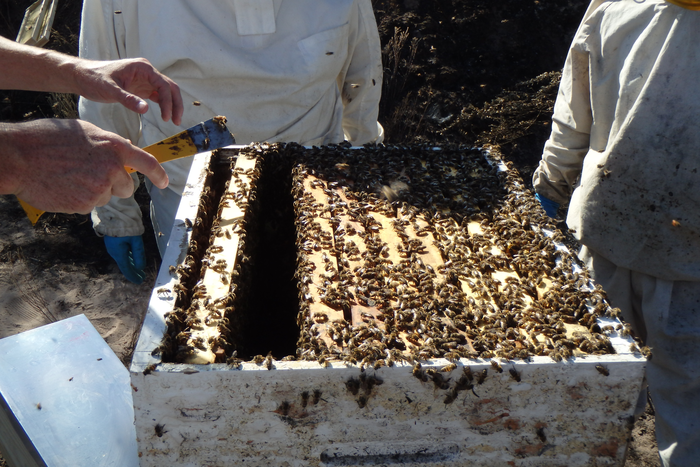Recently discovered genetic knowledge of two nuisance western honey bee subspecies will help commercial and hobby beekeepers.

Credit: Mark Dykes, Honey Bee Research and Extension Laboratory, UF/IFAS
Recently discovered genetic knowledge of two nuisance western honey bee subspecies will help commercial and hobby beekeepers.
A new UF/IFAS study identified genetic characteristics relevant to the production and behavioral attributes of these two key bee subspecies. For example, researchers found Cape bees to be significantly darker than Africanized bees. This dark coloring could be genetically correlated to their undesired behavior.
Both subspecies are undesired in the United States. The first, the “killer bee” or “Africanized honey bee,” known scientifically as A.m. scutellata, is a light-colored bee known for its territorial and defensive nature. This subspecies was taken from its native habitat in South Africa to Brazil in the 1950’s. There, it hybridized with the European bee subspecies kept by Brazilian beekeepers, and then moved into the U.S.
A.m. scutellata are considered invasive bees and can take over colonies of managed honey bees, which can lower profits for beekeepers. They also are known for their heightened defensive behavior.
The second subspecies studied, the “cape honey bee,” known scientifically as A.m. capensis, presents a slew of problems to beekeepers. These bees are more docile but are more likely than African honey bees to take over hives. Cape bees are considered social parasites. Unlike other honey bee subspecies, cape worker bees can clone themselves, producing female eggs without first mating. These clones can take over a hive. These workers cannot reproduce at the same rate as a traditional queen and the colony will eventually dwindle and collapse, a phenomenon coined “capensis calamity.”
“More amazing than the cape bee worker’s ability to clone itself is the rate at which it can take over other colonies,” said Jamie Ellis, UF/IFAS professor. “We are working to ensure these bees do not make their way to the United States because in most cases, when these bees take over a colony, the colony is doomed.”
Genetic studies can be used to understand “why the way things are” for an organism. In this case, researchers sought to understand what genetic traits contribute to the appearance of these bees and their behavior. Using data collected from South African bees from a previous USDA Animal and Plant Health Inspection Service funded study in 2013 and 2014, scientists sought to understand what genes are responsible for the physical characteristics of these subspecies.
“We found really interesting variations in the genes of these bees that can help explain why they look and behave differently,” said Laura Patterson Rosa, UF/IFAS graduate student and co-lead author of the study. “There are a lot of implications to what we found. We have not yet been able to verify these new discoveries in additional populations, but if our findings stand the test of time, it could partially explain why we see behavioral changes, why they do not acknowledge the existence of queens of other subspecies and why they can clone themselves when other bees cannot.”
“Color phenotype is an important aspect to beekeeping management,” said Ellis. “It can help beekeepers know what type of honey bee they have.”
Cape bees are significantly darker than the Africanized bees. This dark coloring could be genetically correlated to their cloning and colony takeover behavior.
“There are potentially over 30 subspecies of honey bees. We investigated only two in the published study,” said Ellis. “Does this finding hold true for the other dark colored honey bee subspecies? It would be interesting to look for these mutations across all western honey bee subspecies to determine if this is the case.”
Curiosity about traits, characteristics and color and how they impact behavior persists as researchers hope to use these findings for future research.
Special thanks to supporters of this research including USDA APHIS and the Florida Department of Agriculture and Consumer Services through the guidance of the Honey Bee Technical Council.
Journal
PLoS ONE
DOI
10.1371/journal.pone.0260833
Article Title
Attack of the dark clones the genetics of reproductive and color traits of South African honey bees (Apis mellifera spp.)
Article Publication Date
14-Dec-2021




